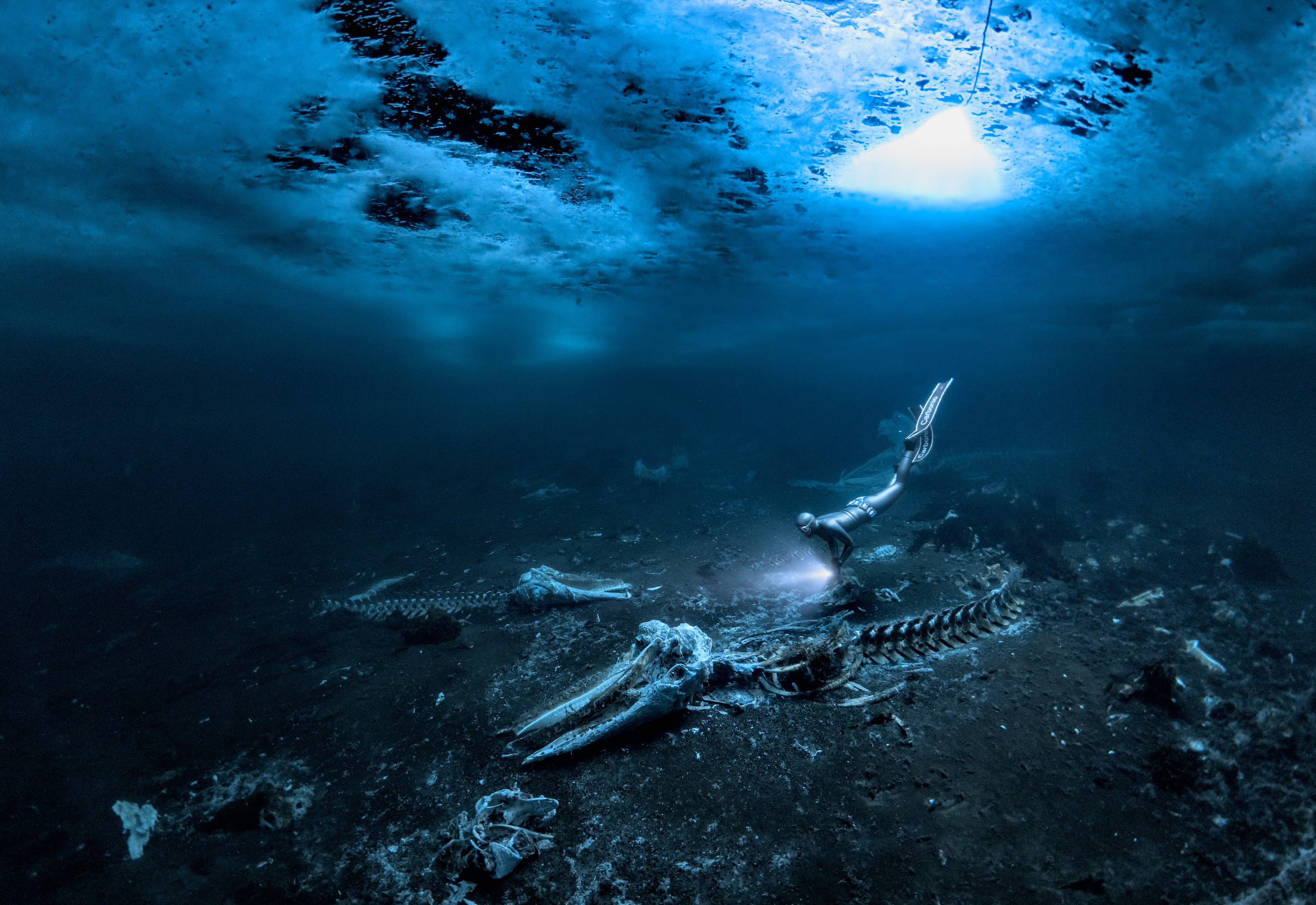Though many of the winning photographs celebrate the beauty of underwater creatures, they also serve as a much-needed wake-up call about the impact humans have on them.
“Since the rise of humans, wild animals have declined by 85%. Today, just 4% of mammals are wildlife; the remaining 96% are humans and our livestock. Our way needs to change to find a balance with nature,” says the chairperson of the judging panel, Alex Mustard.
More than 6,500 entries were received in the 12 categories – from wide angle, portraits and wrecks, to compact cameras and photos taken in British waters.
Read more in Daily Maverick: Untamed talent — take your pic(k) in the Wildlife Photographer of the Year awards
Alex Dawson from Sweden won the overall award with an image titled “Whale Bones”.
We’ve put together some of our favourites, not just winners, in different categories. All the winning photographs can be downloaded for free here . DM
This photo titled 'Nudi on Fire' won the compact camera category. The nudibranch was photographed with an emperor shrimp perched in his head by German photographer Enrico Somogy in Tulamben, Bali. (Photo: © Enrico Somogyi / UPY2024) ‘Attack from Above’ received the runner-up ward in the portrait category. Jon Anderson from the US says: 'Even more surprising than encountering a bird underwater is having the bird try to attack your camera while hunting for small fish in the kelp forest!' Jon had numerous cormorants approach him, peck at his head and try to eat his camera at a popular Monterey dive site. This cormorant paused for a moment and Anderson captured this comedic image of it suspended in the water. Countless species depend on healthy kelp forests to thrive but kelp forests have declined by more than 80% in the past decade due to warmer waters and unchecked predation by urchins. (Photo: © Jon Anderson / UPY2024) The winner of the behaviour category shows a Bryde’s whale engulfing his meal and is aptly titled ‘The End Of A Baitball’. Spanish photographer Rafael Fernandez Caballero was in open waters in Magdalena Bay, Mexico. Bait balls of sardines attracted more species than ever before, thanks to warmer waters as a result of El Niño. (Photo: © Rafael Fernandez Caballero / UPY2024) ‘Chieftain Tanks’ won the wrecks category. Martin Broen from the US was invited to compete in the 1st Aqaba underwater photo competition in Jordan. He viewed an underwater military museum, where war machines are stationed in tactical battle formation 15m to 28m below the surface. He wanted to capture the symmetry of the Chieftain tanks and strong presence of their 120mm guns, but an ambulance prevented him from using his fisheye to get the shot. He took a six-shot panorama from a point between the guns and stitched the photos seamlessly together. (Photo: © Martin Broen / UPY2024) Byron Conory from Iceland took third place in the macro category. His photograph titled ‘Double Pygmy’, taken in Indonesian waters, is described by judge Peter Rowlands as 'highly original'. Conory went on a few dives to get an unusual photograph of a common subject – pygmy seahorses. After exploring various sites in Lembeh he found a sea fan housing 14 seahorses. (Photo: © Byron Conory / UPY2024) ‘An abstract portrait of a Potbelly Seahorse’ taken by Australian Talia Greis won the macro category. Shot in the murky waters of Sydney, Greis says she was drawn to this seahorse because of its distinguished markings around the eye. The colour of the seahorse contrasted so well with the coral surrounding it. Seahorses are not rare on Sydney’s dive sites but Greis always wanted to photograph one that stood out. (Photo: © Talia Greis / UPY2024) ‘Twilight smile’ took third place in the wide angle category. French photographer Rodolphe Guignard noticed several dozen lemon sharks surround the dive boat. This was a few miles from Tiger Beach – 20km off the coast of West End in the Grand Bahamas. (Photo: © Rodolphe Guignard / UPY2024) This story first appeared in our weekly Daily Maverick 168 newspaper, which is available countrywide for R29.
VIDEO
/file/dailymaverick/wp-content/uploads/2024/02/Shelley-UPY-2024-08.jpg)
/file/dailymaverick/wp-content/uploads/2024/02/Shelley-UPY-2024-07.jpg)
/file/dailymaverick/wp-content/uploads/2024/02/Shelley-UPY-2024-05.jpg)
/file/dailymaverick/wp-content/uploads/2024/02/Shelley-UPY-2024-04.jpg)
/file/dailymaverick/wp-content/uploads/2024/02/Shelley-UPY-2024-03.jpg)
/file/dailymaverick/wp-content/uploads/2024/02/Shelley-UPY-2024-02.jpg)
/file/dailymaverick/wp-content/uploads/2024/02/Shelley-UPY-2024-01.jpg)





 ‘Whale bones' won the wide angle category of the Underwater Photographer of the Year 2024 competition. Hunters in Tasiilaq, Eastern Greenland, pull the whale onto the beach during high tide where families cut off the skin, blubber and meat during low tide. The carcass is then pulled back into the sea at the next high tide and the remains are found in the shallow waters where fish and invertebrates pick the bones clean. In Dawson's image a breathhold diver below the Greenland ice sheet looks at the carcass. Hunters take fewer than a dozen minke whales from the healthy population of more than 100,000 in the North Atlantic. (Photo: © Alex Dawson / UPY2024)
‘Whale bones' won the wide angle category of the Underwater Photographer of the Year 2024 competition. Hunters in Tasiilaq, Eastern Greenland, pull the whale onto the beach during high tide where families cut off the skin, blubber and meat during low tide. The carcass is then pulled back into the sea at the next high tide and the remains are found in the shallow waters where fish and invertebrates pick the bones clean. In Dawson's image a breathhold diver below the Greenland ice sheet looks at the carcass. Hunters take fewer than a dozen minke whales from the healthy population of more than 100,000 in the North Atlantic. (Photo: © Alex Dawson / UPY2024)